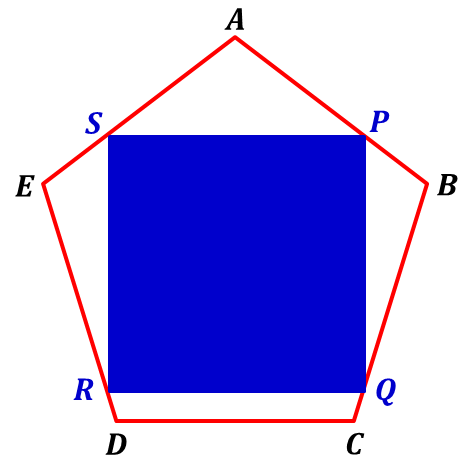A Maximal Square
Let a be the side length of a regular pentagon, and let b be the side length of the largest square that can be inscribed in that pentagon. Find the value of ⌊ 1 0 0 0 b a ⌋ .
(The floor function ⌊ x ⌋ gives the greatest integer less than or equal to the real number x .)
The answer is 936.
This section requires Javascript.
You are seeing this because something didn't load right. We suggest you, (a) try
refreshing the page, (b) enabling javascript if it is disabled on your browser and,
finally, (c)
loading the
non-javascript version of this page
. We're sorry about the hassle.
2 solutions
Anish, in my opinion that square is not inscribed in the pentagon because the bottom corner is not contact with the base of pentagon. As far as I know, the term 'inscribed' means all the vertices must lie on the sides of outer shape. It should be like this:
 Square in Pentagon
Square in Pentagon
Log in to reply
I dont think it can be done. I searched everywhere for the above figure, but instead, I only found the one that I used in my solution.
Are you certain that the above shape that you drew is a square? (I do not mean any suspicion)
Log in to reply
Geez, my bad Anish. Your solution is correct. Indeed, P Q R S in my picture is a square but it doesn't yield the maximum area of square like yours. I don't know some how my answer is 'correct' although it's not the correct answer. Lucky me. :D
it isn't the largest square
Tunk-Fey, your suggestion does not give the maximum area. It's off by about 4.8% of the maximum. I checked it out on AutoCAD.
but you must give a reason why it is so?
good.
well done
i thought it was mixed fraction. :'( question should be written clearly.
This square is not inscribed in the pentagon. All four corners of the square have to lie on the pentagon, for it to be truly inscribed.
Nice solution
b/sin108=a/sin63 in the triangle formed by taking one of corners of largest square as corners of pentagon . a/b=sin63/sin108. 1000a/b=936.85 gif=936
I agree that inscribed should mean all edges lie on the curve. For the sake of Mathematics, this problem should explicitly state the fact of a common edge .
I would like to see a proof that this is the maximum.
Note : The following figure is the only way I think you could inscribe a square in a pentagon (please tell me it is)
Considering the above figure,
The angle ∠ B A C is clearly 2 1 0 8 o − 9 0 o = 9 o
Hence,
∠ B C A = 1 8 0 − ( 1 0 8 + 9 ) = 6 3 o
Using Sine Rule in Δ A B C ,
sin 6 3 o a = sin 1 0 8 o b
Thus,
b a = 0 . 9 3 6 8
⇒ ⌊ 1 0 0 0 b a ⌋ = ⌊ 9 3 6 . 8 ⌋ = 9 3 6